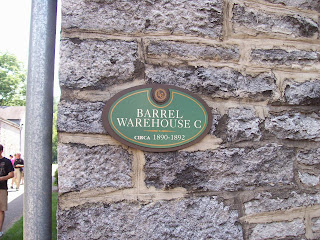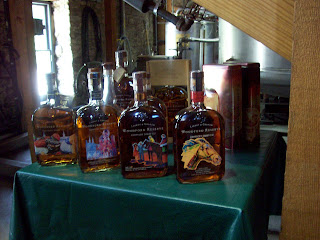Kentucky Bourbon
Kentucky is known for its bourbon and luckily for us, a few distilleries were a short drive from Lexington. Prior to leaving home I had done some research and had decided that The Woodford Reserve Distillery would make a great side trip. As I refused to pay $12.95 a day for Internet access at the hotel, I was glad that I had done my homework before leaving home.
Saturday was hot and humid, but we bravely left the climate-controlled environment of the hotel to venture out to the countryside and the distillery.
 After buying tickets for the next available tour, we wandered around the spacious history center/tasting room of the visitor center.
After buying tickets for the next available tour, we wandered around the spacious history center/tasting room of the visitor center. We had been informed that we would be given a sample of the bourbon after our tour.
Kentucky is known for its fine bourbons because of the numerous limestone springs that produce "sweet water".
A final note: all bourbon is whisky, but all whisky is not bourbon.
 The distillery has some art on display.
The distillery has some art on display. It was time for our tour to start and we followed our guide out into the hot June day. We have been assured that there are 72 steps down to the valley where the distillery sits.
It was time for our tour to start and we followed our guide out into the hot June day. We have been assured that there are 72 steps down to the valley where the distillery sits. First we go into the distillery building. This building dates to 1840. Notice the mill stone above the door?
First we go into the distillery building. This building dates to 1840. Notice the mill stone above the door? This distillery has been designated a National Historic Landmark.
This distillery has been designated a National Historic Landmark.  Our tour guide starts off by giving us the list of ingredients in bourbon, as well as the government guidelines. To wit, corn must comprise at least 51% of the grain content and the final product can be no more than 160 proof (80% alcohol by volume).
Our tour guide starts off by giving us the list of ingredients in bourbon, as well as the government guidelines. To wit, corn must comprise at least 51% of the grain content and the final product can be no more than 160 proof (80% alcohol by volume).  The mixture first goes into the mash cooker.
The mixture first goes into the mash cooker. From there it goes into a fermenter made from cypress. No trees were cut down for these vat, as the wood was reclaimed from the bottom of the swamps.
From there it goes into a fermenter made from cypress. No trees were cut down for these vat, as the wood was reclaimed from the bottom of the swamps. Coils line the vats. Water is pumped through the coils, thus helping to regulate the temperature of the mixture.
Coils line the vats. Water is pumped through the coils, thus helping to regulate the temperature of the mixture. The aroma of yeast is heavy in the air.
The aroma of yeast is heavy in the air.It's Alive! Mwahahahaha!
 Now we move on to the distillery room.
Now we move on to the distillery room. The Woodford Reserve Distillery is the only one in the country that uses copper stills.
The Woodford Reserve Distillery is the only one in the country that uses copper stills. The safe. Here samples are collected and stored. In prior years, the samples were kept in this locked safe so that the government could come in and check the samples, confident that no tampering had occurred. Likewise, the distillery could rest assured that the government was not cheating them out of more tax money.
The safe. Here samples are collected and stored. In prior years, the samples were kept in this locked safe so that the government could come in and check the samples, confident that no tampering had occurred. Likewise, the distillery could rest assured that the government was not cheating them out of more tax money. The barrels are rolled down the 500 foot barrel run to the barrel warehouse.
The barrels are rolled down the 500 foot barrel run to the barrel warehouse. This Barrel Warehouse was built about 1890. The stone walls are about two feet thick and help to regulate the temperatures inside.
This Barrel Warehouse was built about 1890. The stone walls are about two feet thick and help to regulate the temperatures inside. We learned that this distillery was one of only a handful of distilleries that had permission to operate and make "Medicinal alcohol" during the years of Prohibition.
We learned that this distillery was one of only a handful of distilleries that had permission to operate and make "Medicinal alcohol" during the years of Prohibition.  Already we can smell "The Angel's Share", the bourbon that evaporates off during the aging process. Our guide tells us that up to 30% of the product in the barrels evaporates during this time.
Already we can smell "The Angel's Share", the bourbon that evaporates off during the aging process. Our guide tells us that up to 30% of the product in the barrels evaporates during this time. The lower end of the barrel run.
The lower end of the barrel run. And here are the rails that hook over the door sill, allowing the barrels to be rolled inside the building.
And here are the rails that hook over the door sill, allowing the barrels to be rolled inside the building. Aging barrels.
Aging barrels. Lots of aging barrels.
Lots of aging barrels. If you click on this picture, you can see some of the "bourbon honey" seeping through the holes where samples of the liquor were taken.
If you click on this picture, you can see some of the "bourbon honey" seeping through the holes where samples of the liquor were taken.By law, only new barrels can be used to make bourbon. The distillery sells their old barrels to whisky distilleries, often in Ireland and Scotland.
 Woodford Reserve limits its bourbon production so that they can maintain the old traditions of handcrafted bourbon-making.
Woodford Reserve limits its bourbon production so that they can maintain the old traditions of handcrafted bourbon-making. Woodford Reserve Bourbon is the official bourbon of the Kentucky Derby. The distillery has collector bottles to commemorate the event.
Woodford Reserve Bourbon is the official bourbon of the Kentucky Derby. The distillery has collector bottles to commemorate the event.






















3 comments:
Very interesting. Thank you.
What a fascinating place. @ things:
1) those copper stills are the coolest things ever
2) can't the bourbon industry police itself? Why does there need to be a law about the barrels? That seems as silly to me as making a law about what kind of strawberries you have to use to make jam. Too much government, I tell ya.
I think that much of government's time is spent in figuring out new ways of creating work (and money) for itself.
Post a Comment